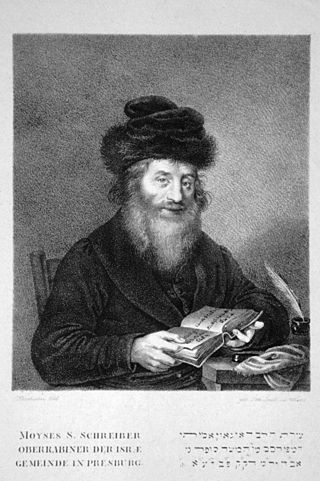
Moses Schreiber (1762–1839), known to his own community and Jewish posterity in the Hebrew translation as Moshe Sofer, also known by his main work Chatam Sofer, Chasam Sofer, or Hatam Sofer, was one of the leading Orthodox rabbis of European Jewry in the first half of the nineteenth century.
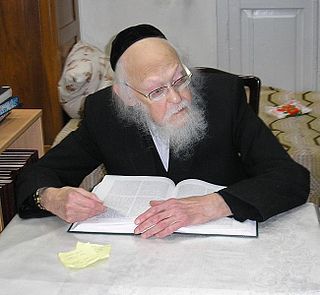
Yosef Shalom Elyashiv was a Haredi rabbi and posek who lived in Jerusalem. Until his death at the age of 102, Rav Elyashiv was the paramount leader of both Israel and the Diaspora Litvak-Haredi community, and many Ashkenazi Jews regarded him as the posek ha-dor, the contemporary leading authority on halakha, or Jewish law.

Aaron Teitelbaum is one of the two Grand Rebbes of Satmar, and the chief rabbi of the Satmar community in Kiryas Joel, New York.

Dushinsky is one of the few Hasidic dynasties not named after the place where it originated; instead, it is named after the rebbe's surname. It is relatively new, and became a dynasty in Jerusalem, where it is centered today. Unlike other Hasidic groups, it does not originate from a Hasidic background, but from the talmidim (students) of Moses Sofer.

The Charedi Council of Jerusalem is a large Haredi Jewish communal organization based in Jerusalem. It has several thousands affiliated households and is chaired by the Gaon Convenor (Ga'avad). The Council provides facilities such as dietary laws supervision, ritual baths, a Sabbath enclosure, and welfare services.

Har HaMenuchot is the largest cemetery in Jerusalem. The hilltop burial ground lies at the western edge of the city adjacent to the neighborhood of Givat Shaul, with commanding views of Mevaseret Zion to the north, Motza to the west, and Har Nof to the south. Opened in 1951 on 300 dunams of land, it has continually expanded into new sections on the northern and western slopes of the hill. As of 2008, the cemetery encompasses 580 dunams in which over 150,000 people are buried.

Zelig Reuven Bengis was the Chief Rabbi of Jerusalem for the Edah HaChareidis. He wrote a seven-volume commentary on the Talmud, called "Leflagos Reuven".

Yosef Tzvi Dushinsky, also known as the Maharitz, was the first Rebbe of Dushinsky and Chief Rabbi (Gavad) of the Edah HaChareidis of Jerusalem.
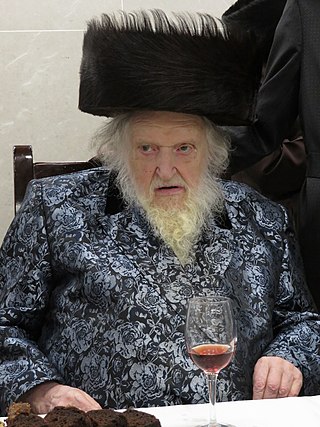
Moshe Sternbuch is a British-born Israeli Haredi rabbi. He serves as the ga'avad of the Edah HaChareidis in Jerusalem, and the rabbi of the Gra Synagogue in the Har Nof neighbourhood.

Ezrat Torah is a Haredi neighborhood in northern Jerusalem. It is bordered by Kiryat Sanz on the west, Golda Meir Blvd. on the north and east, and Shikun Chabad and Tel Arza on the south.

Shmuel HaNavi Street is a main road in north-central Jerusalem. It starts at the intersection of St. George and Shivtei Israel Streets near Highway 60, and merges into Golda Meir Boulevard just past the intersection of Bar-Ilan and Hativat Harel Streets. The continuation of the street winds up to the tomb of Samuel the prophet, after whom the street is named.

Sanhedria Cemetery is a 27-dunam (6.67-acre) Jewish burial ground in the Sanhedria neighborhood of Jerusalem, adjacent to the intersection of Levi Eshkol Boulevard, Shmuel HaNavi Street, and Bar-Ilan Street. Unlike the Mount of Olives and Har HaMenuchot cemeteries that are located on the outer edges of the city, Sanhedria Cemetery is situated in the heart of western Jerusalem, in proximity to residential housing. It is operated under the jurisdiction of the Kehilat Yerushalayim chevra kadisha and accepts Jews from all religious communities. As of the 2000s, the cemetery is nearly filled to capacity.
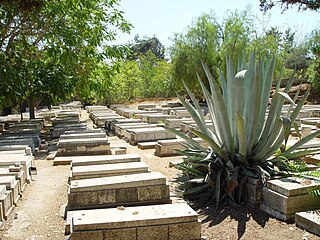
Sheikh Badr Cemetery is an 8 dunams Jewish burial ground in west-central West Jerusalem. It was established as a temporary burial ground during the 1948 Arab siege of Jerusalem. Most of its military and civilian graves were transferred to Mount Herzl and Har HaMenuchot, respectively, in late 1950. The cemetery continued to accept burials up until the official opening of Har HaMenuchot in November 1951.
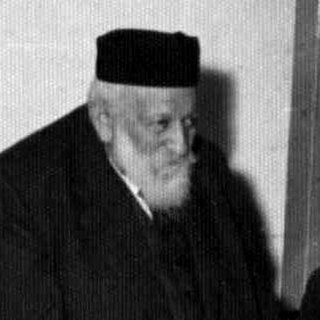
Moshe (Moritz) Wallach was a German Jewish physician and pioneering medical practitioner in Jerusalem. He was the founder of Shaarei Zedek Hospital on Jaffa Road, which he directed for 45 years. He introduced modern medicine to the impoverished and disease-plagued citizenry, accepting patients of all religions and offering free medical care to indigents. He was so closely identified with the hospital that it became known as "Wallach's Hospital". A strictly Torah-observant Jew, he was also an activist in the Agudath Israel Orthodox Jewish movement. He was buried in the small cemetery adjacent to the hospital.
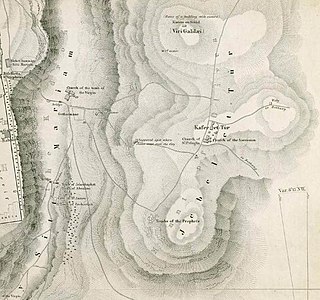
The Jewish Cemetery on the Mount of Olives is the oldest and most important Jewish cemetery in Jerusalem. The Mount of Olives has been a traditional Hebrew/Jewish burial location since antiquity, and the main present-day cemetery portion is approximately five centuries old, having been first leased from the Jerusalem Islamic Waqf in the sixteenth century. The cemetery contains anywhere between 70,000 and 150,000 tombs, including the tombs of famous figures in early modern Jewish history. It is considered to be the largest and holiest historical Jewish cemetery on earth.

Yosef Tzvi Dushinsky is the third Rebbe of the Dushinsky Hasidic dynasty of Jerusalem, Israel. He assumed the leadership of the Hasidut upon the death of his father, Rabbi Yisroel Moshe Dushinsky, second Dushinsky Rebbe, in 2003. The Dushinsky Hasidic movement was founded by his grandfather and namesake, Rabbi Yosef Tzvi Dushinsky, in Jerusalem in the 1930s. Both his father and grandfather also served as Gaavad of the Edah HaChareidis.
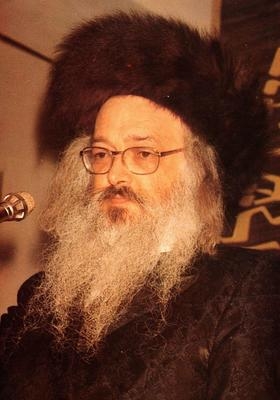
Yisroel Moshe Dushinsky also known as the Maharim, was the second Rebbe of the Dushinsky Hasidic dynasty of Jerusalem, Israel. He assumed the leadership of the Hasidut at the age of 28 upon the death of his father, Rabbi Yosef Tzvi Dushinsky, founder of the dynasty. He was also a member of the rabbinical court of the Edah HaChareidis for over 40 years, completing his tenure as the seventh chief rabbi of the Edah HaChareidis from 1996 to 2003.
Yaakov Yeshayah Blau (1929–2013) was a rabbi and a dayan on the Badatz of the Edah HaChareidis in Jerusalem. He was known as an expert in the halakhot of Choshen Mishpat and served as halakhic decisor for over 50 years.
Givat Moshe, also known as Gush Shemonim, is a Haredi Jewish neighborhood in Jerusalem bordering on Sanhedria, Mahanayim, Ezrat Torah, Shikun Chabad, and Tel Arza.




















